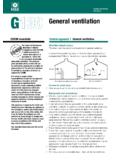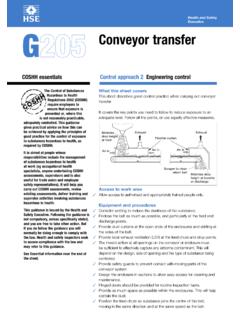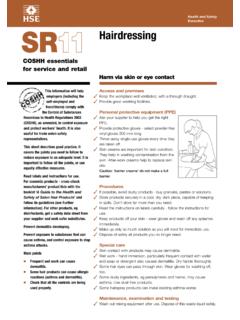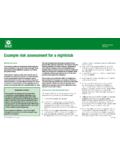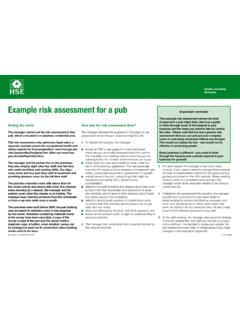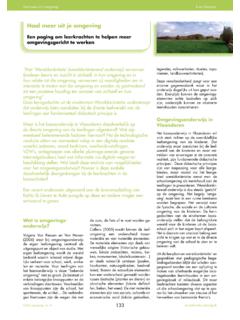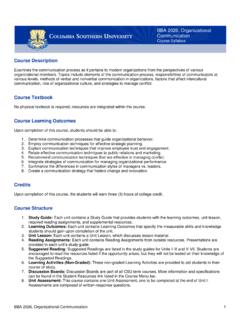Transcription of Working with substances hazardous to health
1 health and Safety Executive1 of 10 pagesThis is a web-friendly version of leaflet INDG136(rev4), revised 06/09 Working with substances hazardous to healthWhat you need to know about COSHHI ntroductionThis leaflet describes how to control hazardous substances at work so that they do not cause ill health . It will help you understand what you need to do to comply with the Control of substances hazardous to health (COSHH) Regulations 2002 (as amended) which apply to the way you work with these you run a small business or are self-employed, you need this information to make sure you are protecting your employees. If you run a medium-sized or large business, where decisions about controlling hazardous substances are more complex, you will also need professional advice. The leaflet will also be useful for trade union and employee health and safety do I need to read this leaflet?Every year, thousands of workers are made ill by hazardous substances , contracting lung disease such as asthma, cancer and skin disease such as dermatitis.
2 These diseases cost many millions of pounds each year to:industry, to replace the trained worker;Qsociety, in disability allowances and medicines; and Qindividuals, who may lose their , as the employer, are responsible for taking effective measures to control exposure and protect health . These measures can also improve production or cut after your businessYour aim in running your business is to make a profit. You know what you do, and how you are doing it. You know what processes and tasks are involved. You know the short cuts. Ensuring your workers remain healthy may also lead to healthy substances are harmful?Dusty or fume-laden air can cause lung diseases, eg in welders, quarry workers Qor woodworkers. Metalworking fluids can grow bacteria and fungi which cause dermatitis and , bulbs, fruit and vegetables can cause Working , eg catering and cleaning, can cause dermatitis. QBenzene in crude oil can cause Of course it s safe we ve always done it this way.
3 Reality Some diseases take years to develop. If exposure is high because the task has always been done that way, maybe it s time for a of 10 pagesHealth and Safety ExecutiveWorking with substances hazardous to healthMany other products or substances used at work can be harmful, such as paint, ink, glue, lubricant, detergent and beauty health caused by these substances used at work is preventable. Many substances can harm health but, used properly, they almost never do. Find out the dangers in your business ask your supplier, your trade association, and check for your trade on HSE s website: can also have dangerous properties. They may be flammable, for example solvent-based products may give off flammable vapour. Clouds of dust from everyday materials, such as wood dust or flour, can explode if ignited. This leaflet does not deal with flammability or explosion hazards (see Find out more ). Look at each substanceWhich substances are involved?
4 In what way are they harmful? You can find out by:checking information that came with the product, eg a safety data sheet;Qasking the supplier, sales representative and your trade association;Qlooking in the trade press for health and safety information;Qchecking on the Internet, eg HSE s website pages for your about the taskIf the substance is harmful, how might workers be exposed?Breathing in gases, fumes, mist or dust?QContact with the skin? QSwallowing?QContact with the eyes? QSkin puncture?QBear these in mind when you look at the tasks. Exposure by breathing inOnce breathed in, some substances can attack the nose, throat or lungs while others get into the body through the lungs and harm other parts of the body, eg the by skin contactSome substances damage skin, while others pass through it and damage other parts of the body. Skin gets contaminated:by direct contact with the substance , eg if you touch it or dip your hands in it;Qby splashing;Qby substances landing on the skin, eg airborne dust;Qby contact with contaminated surfaces this includes contact with Qcontaminationinside protective by swallowingPeople transfer chemicals from their hands to their mouths by eating, smoking etc without washing to the eyesSome vapours, gases and dusts are irritating to eyes.
5 Caustic fluid splashes can damage eyesight by skin punctureRisks from skin puncture such as butchery or needlestick injuries are rare, but can involve infections or very harmful substances , eg It s natural so it can t be harmful. Reality Natural materials can be harmful. For example, henna can cause dermatitis and asthma, wood dust can cause asthma, stone or concrete dust can cause lung disease such as silicosis, and citrus oils can cause skin I don t work with harmful substances . Reality Most businesses use substances that can be hazardous to health even something as simple as flour can act as a substance hazardous to of 10 pagesHealth and Safety ExecutiveWorking with substances hazardous to healthSafety data sheets Products you use may be dangerous for supply . If so, they will have a label that has one or more hazard symbols. SThese products include common substances in everyday use such as paint, bleach, solvent or fillers.
6 When a product is dangerous for supply , by law, the supplier must provide you with a safety data sheet. Note: medicines, pesticides and cosmetic products have different legislation and don t have a safety data sheet. Ask the supplier how the product can be used data sheets can be hard to understand, with little information on measures for control. However, to find out about health risks and emergency situations, concentrate on:QPart 15 of the sheet, which tells you what the dangers are;QParts 4 to 8, which tell you about emergencies, storage and symbols will replace the European symbols in 2009. Some of them are similar to the European symbols but there is no single word describing the hazard. Read the hazard statement on the packaging and the safety data sheet from the toxicHarmfulIrritantHighlyExtremelyExplo siveDangerous toflammableflammablethe environmentOxidisingCorrosiveT+iF+Europe an symbolsNew International symbolsHazard checklist Does any product you use have a danger label?
7 Does your process produce gas, fume, dust, mist or vapour? Is the substance harmful to breathe in? Can the substance harm your skin? Is it likely that harm could arise because of the way you use or produce it? What are you going to do about it? Use something else? Use it in another, safer way? Control it to stop harm being caused?Assessing riskRisk assessment is not just a paper exercise. It s about taking sensible steps to prevent ill health . You need to know how workers are exposed, and to how much, before you can decide if you need to do anything to reduce their exposure. The COSHH Regulations require employers to assess the risk to their employees, and to prevent or adequately control those risks. Sometimes, it s easy to judge the amount of exposure to substances and decide what you can do about the task involves very small amounts of material, even if these are harmful, when there is little chance of it escaping, the risk is low.
8 But the risk in a different task such as cleaning up and disposal will be higher because the harmful substance may be breathed in or get onto the the task involves larger amounts of material, with obvious leaks, exposure is higher and so is the risk. Whether the substance is harmful or not, your need to control it is obvious. Decide what measures you need to take, and of 10 pagesHealth and Safety ExecutiveWorking with substances hazardous to healthIf you have five or more employees, you must record your assessment but, even if you have fewer than five, it makes sense to write down what steps you have taken to identify the risks. And the really important part is making a list of the actions you are taking to control the risks to health . You can look at examples of risk assessments for different industries on has developed a free internet tool for identifying good control practice: It covers a wide range of processes and activities and also produces advice for products that have safety data sheets.
9 However, there may be no good practice advice available for your process. Where this is small-scale with obvious control measures, you can do the assessment yourself. In other cases, or where you are not sure, ask your supplier, trade association, HSE s Infoline, or other reliable information sources. You may need professional advice such as from an occupational hygienist see Getting help .What are exposure control measures?Control measures are always a mixture of equipment and ways of Working to reduce exposure. The right combination is crucial. No measures, however practical, can work unless they are used any standard operating procedure should combine the right equipment with the right way of Working . This means instructing, training and supervising the workers doing the tasks. You need control measures that work and continue to work all day, every day. Examples of control measuresMyth What do you expect it s a dirty job!
10 Reality Why does your job need to be dirty? Think about changing the way you work to produce cleaner ,process ControlequipmentWay of workingManagingQCleaning with solvent on a rag a small bin with a lid for used rags. QAvoid skin solvent vapour from used controls are and sparks from abrasive an enclosure around the wheel and extract the air to a safe the airflow indicator. QMake sure the extraction controls as required by from welding helmet, outdoors upwind of the fume wherever the fume to clear before removing if there is any lead paint on the scrap being out health from a lathe. an enclosure around the lathe and extract the air to a safe skin-care sure the extraction time for the mist to clear from the enclosure before opening and maintain fluid controls as required by out health from disc cutter on stone an enclosure to extract air to a safe place.




